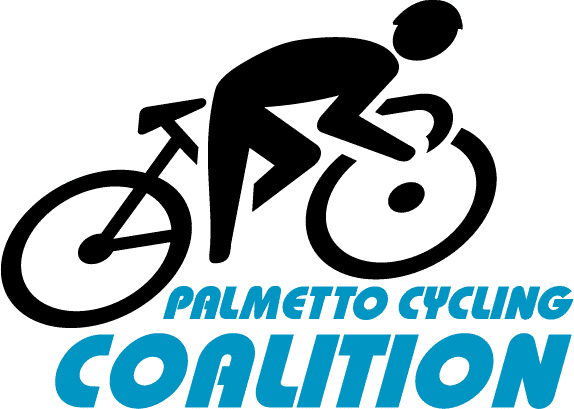Communities for Cycling
Communities for Cycling (C4C), a partnership of local transportation planners & engineers throughout SC, recently advised SCDOT on their Highway Design Manual (HDM). The Department is currently rewriting it to keep up with new federal guidance.
The Palmetto Cycling Coalition facilitates C4C, a membership-based group of planners & engineers from around the state, serving as recording Secretary, but we don’t lead the effort. The great thing is it leads itself. Led by a Working Group composed of Directors from Planning Departments in Charleston, Rock Hill, Greenville, Clemson, and Sumter, the larger membership group includes folks from almost every major city or regional planning body in the state. And yes, it leads itself. Municipalities in SC decided at some point that focusing on bike/ped infrastructure was a good idea. It just makes sense. Planning for transportation and land use at the local level means you pay attention to issues of accessibility to the front door of Main Street businesses. And that’s where bike/ped infrastructure makes sense.
C4C serves to provide a forum of collaboration between planners & engineers already knowledgeable about bike/ped infrastructure in SC and those wanting to learn more. It also serves as a collaborative tool for working directly with the state. That’s where the recent work came into play: working with the SCDOT in how they plan to design our state owned roads today and 10 years down the road. SCDOT is currently rewriting this Highway Design Manual, and since the last time this occurred was 2003, getting input from local governments is appreciated. It’s also important business for C4C.
C4C recently submitted 8 pages of comments to the current HDM draft. The group now awaits word from SCDOT. Comments were essentially these:
- allow bicycle accommodation considerations for lane reconfigurations (retrofits)
- include sharrows and cycle tracks to the list of bicycle facilities
- selection of an appropriate bikeway facility requires the following information: bicycling demand (current and future), connectivity information such as whether there is contraflow demand, and transit uses/stops along a corridor
- consult local or regional Bicycle Master Plans or Comprehensive Plans for integration, and when questions on bikeway type arises, consult those respective departments
- when rumble strips are necessary, always utilize reduced footprint, in addition to reviewing local bicycle plans to make appropriate exclusions,
- on high grade roads, provide considerations to wide (15 ft) travel lanes for shared use
- allow for variable bike lane width down to 4 feet
- include bikeway designs for 1 way streets
- for all roadway cross section designs, allow greater variability in lane width, especially to facilitate local decision making regarding road user safety (and for preserving local freedom to make decisions on how to accommodate local road users and their needs). This will allow local and state road designers great flexibility in collaborating in state-owned, urban street design.
- Please add this policy (we were only commenting on bike facilities, not pedestrian facilities)
Bicycle Warrants:
- Standards– Bicycle accommodations shall be considered in all planning studies and included in all reconstruction, new construction, and capacity-adding projects that are located in areas with any of the following conditions:
- if the project is on a designated (i.e, adopted) US, State, regional, or local bicycle route;
- where there is an existing bikeway along or linking to the end of the project corridor (e.g., shared lane, paved shoulder, bike lane, bike boulevard, or shared-use path);
- along corridors with bicycle travel generators and destinations (i.e. residential neighborhoods, commercial centers, schools, colleges, scenic byways, public parks, transit stops/stations, etc.);
- on projects where a bridge deck is being replaced or rehabilitated and the existing bridge width allows for the addition of a bikeway without eliminating (or precluding) needed pedestrian accommodations; and
- where there is an occurrence of reported bicycle crashes which equals or exceeds five for a 1-mile segment of roadway, over the most recently three years for which crash data is available.
Guidelines – Bicycle accommodations should be should be considered on projects that are located in areas with any of the following conditions:- within close proximity (i.e., 3 miles) of a school, college, university, or major public institution (e.g., hospital, major park, etc.,..);
- where a project will provide connectivity between two of more existing bikeways or connects to an existing bikeway;
- where there is an occurrence of bicycle crashes;
- along a corridor where bicycle travel generators and destinations can be expected prior to the design year of the project;
- any location where engineering judgment, planning analysis, or the public involvement process indicates a need.
Exclusions – The consideration of bicycle warrants may be excluded from roadways with any of the following conditions:- for very low speed (i.e., <35mph) residential roadways where bicyclists can safely share the roadway with motor vehicles; and on side road tie-ins where there is no existing sidewalk or bicycle accommodation and widening of construction limits for sidewalk or bicycle accommodation would result in disproportionate impacts to adjacent property (as decided by the project development team on a case-by-case basis)
For more information on Communities for Cycling, please visit PCC’s C4C webpage, or contact Amy.
